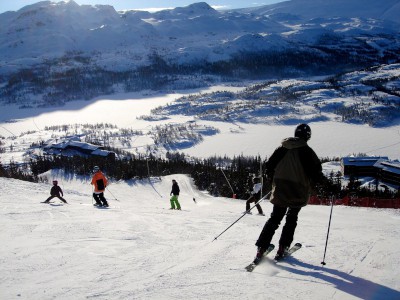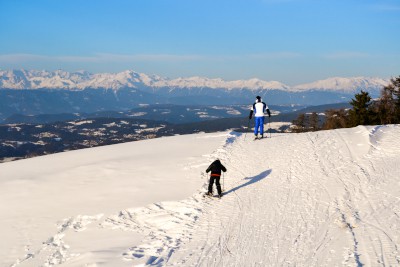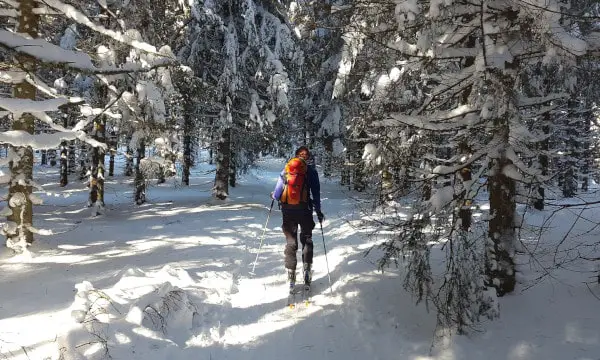Table of Contents
Skiing downhill while cross-country skiing can be an intimidating task as it requires a unique combination of endurance, speed, and strength to maintain your pace and avoid injuries.
5 Reasons Downhill Cross-Country Skiing is Difficult
1. Lack of Stability
Downhill cross-country skiing is far less stable than alpine skiing, making it far more challenging. In cross-country skiing, you fasten the boots to the front of your shoe tips, making the attachment unstable and shaky. Other than that, cross-country skis are much narrower than an alpine ski and weighs relatively less as well, making it categorically more unbalanced and unreliable. The rounded shape and lack of metal edges make clinging onto snow harder.
All of these features contribute towards making it difficult to control speed. Alpine skis have parabolic cuts made to excel in sharp turns, whereas cross-country skis have straight cuts with no promising features to handle speed, especially during sharp turns.
Speed control is essential, as most cross-country skiers accelerate relatively quickly because of the lightweight design.
Beginners should avoid steep downhill tracks, as they contribute majorly towards accidents through loss of speed control downhill. It is always a better choice to take your skis off and walk your way down in this situation, especially for newcomers in the field.

2. Difficulty of Terrain
Cross-country skiing trails are often made in areas surrounded by tall trees with a narrow passage to pass by.
The terrain has numerous blind spots and dodgy areas that are challenging to maneuver and particularly dangerous for beginners.
Groomed trails for cross-country skiing are considerably narrow and only provide space for one skier per track. As a beginner, you should always go for groomed areas made for beginner cross –country skiers, that are usually wider. There, you should learn to control your speed during downhill turns while avoiding blind spots. Once you have enough practice, you can opt for classic trails and ungroomed downhill skiing areas.
3. No Groomed Trails on Downhill Turns
Groomed and maintained tracks for cross-country skiing are prepared in such a way that groomers lift up the trackset on certain areas, especially at downhill turns.
Often there are times when ski tracks are in place, but they might be too dangerous to ski in for a number of reasons.
Firstly, if you ski in track on downhill turns, you might find yourself following a track of someone who couldn’t make the turn, thus leading you as well in the ditch.
Secondly, changing weather conditions might be a much greater challenge at high-speed downhill turns. If the weather is different compared to what it was when the trail was groomed, it could pose a risk to an unexperienced skier.
Finally, you are likely not trained to make sharp turns, and your expertise in skiing has not prepared you for the levels the track was groomed for.
For these reasons, even well-maintained cross-country ski areas advise groomers to lift up the trackset machine at downhill turns, making XC skiers to approach downhill turns with caution.

4. Trail and Snow Conditions
The best way to minimize the risk associated with downhill skiing is to avoid trails that might turn out to be more difficult than what you are trained to handle. These conditions might be caused by abrupt weather changes or a trail that involves potentially risky turns.
Often, a trail whose difficulty level you can manage in normal conditions can turn out to be dangerous for you in icy conditions.
Other than that, ski centers measure the difficulty levels of trails according to their own measuring criteria. This might confuse you a bit as two trails similar to each other might be labeled difficult in one center and easy in the other.
There are times when climbing a slope might seem easier, but skiing down on it might turn out to be difficult than you anticipated. So it is always a wise choice to assess the snow conditions before you start skiing on a particular track.
The snow that is soft and manageable during the early hours of the day might turn icy and hard later, making it risky for you to ski on. Snow shadowed by trees and other things might be softer than snow exposed to the sun throughout the day.
All in all, it’s better to ask someone local in the area to assess the snow conditions for you and tell you whether the snow and trail conditions are safe to ski in.

5. It’s Just Scary
Downhill cross-country skiing can be a scary deal for you, especially if you are a beginner. You might have problems controlling speed, especially on sharp turns or trails designed for skiers with greater expertise.
Other than that, you might also not be able to stabilize yourself while skiing in the beginning. This might put you out of control of the track and might turn out to be a terrifying experience for you.
How to Stop on Cross-Country Skis
Cross-country skiers have four techniques to stop while going down a slope, depending on the kind of maneuvers they make. These are essential for any new XC skier to learn, as they provide the technique and confidence for controlling your skinny skis when going downhill with increasing speed.
These are snowplowing, parallel skidding, step turning, and tucking – learn and practice how to stop on cross-country skis.


